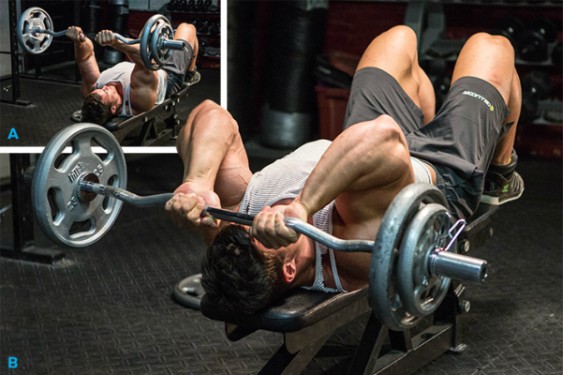When cluster training you can easily manipulate the sets, reps and rest scheme. By doing this you are allowing yourself to induce strength or hypertrophy gains.
If gaining strength is your target, then aim to keep the load of the movement high (at or above 90% of your 1RM), and the reps low (sets of 1-2 reps), with short rests (10-15s).
If it’s for hypertrophy, clusters allow you to use a weight that you regularly use for building strength (i.e. a 5RM), but push the number of reps you can do into the reps ranges of 8-12 reps. This increases the total time under tension, and places a greater degree of mechanical stress placed upon the muscle.
Cluster training has the ability to break through strength plateaus. They are also sets with built-in, short rest periods of 10-15 seconds. They allow for creative manipulation and combinations of volume and intensity.
The benefits of cluster training come from the ability to do more reps with a heavier weight. If you’re able to keep intensity high whilst doing more reps, you’re going to see an immediate carry over to improvements in strength and muscle gains.
Cluster training involves using short, inter-set rest periods, which allow you to do more reps with a heavier weight. The difference between cluster training and traditional lifting is that in traditional lifting, for example:
- You would perform your sets of squats for 5 reps, rest for 2-3 minutes between sets, and then move on to the second set.
- In cluster training you break that set of 5 reps down into 4 mini-sets of 2 reps, with a 10-15 second break in between each mini-set. This effectively allows us to do 8 reps of squats with our 5RM.
3 extra reps doesn’t seem like much, but it equates to a 60% increase in output, you can notice how effective cluster training can be.

Clusters For Muscle Mass:
Training volume is needed for growth. The amount, depends on the individual.
High-threshold motor units, the ones best suited for hypertrophy, are best recruited at high training intensities, accompanied by greater motor unit synchronisation and greater muscular force.
Cluster sets allow for motor unit synchronisation, high levels of muscular force, and the recruitment of high-threshold motor units without fatigue. Heavier weights for more reps, will give you muscle mass.
Think about the metabolic disturbance created by session density. Rest periods are easily manipulated while working at higher relative intensities, more load is handled in a shorter amount of time. As rest periods are cut there is a big metabolic disturbance.
Size Cluster Strategy:
We need to build volume and stress while maintaining intensity, so we’ll build our size clusters using doubles and triples. Intensity, remains relatively constant, volume and rest are manipulated to elicit a training effect.
| Week | Sets | Cluster Reps | Rest | Intensity | Rest – Sets |
| 1 | 4 | 2-2-1 * | 15 sec. | 7-8 | 90-120 sec. |
| 2 | 4 | 2-2-2 * | 15 sec. | 7-8 | 90-120 sec. |
| 3 | 5 | 3-2-2 * | 15 sec. | 7-8 | 90-120 sec. |
| 4 | 4 | 3-3-2 * | 10 sec. | 7-8 | 90-120 sec. |
| 5 | 4 | 3-3-3 * | 10 sec. | 7-8 | 90-120 sec. |
| 6 | 5 | 3-3-3 * | 10 sec. | 7-8 | 90-120 sec. |
* The dash signifies the rest taken between clusters.
During the last week of this progression, 45 reps are completed at a high intensity in eight and a half minutes. That’s enough stress and density to make you grow.
This strategy works for main lifts and first level accessory movements. Be sure, not to accumulate too much fatigue during your main lift if you plan on using this progression to load your assistance move.
What about the straight sets? While they may still work, you’ll want to increase them to your secondary exercises with this setup, keeping the reps between 5-8. Progress up to 4 sets of 8 reps or 5 sets of 5. You’ll get plenty of volume with appropriate intensity.
Clusters For Building Strength:

Strength is the result of neurological output. That’s why lifters are constantly rotating exercises (which are more similar than they are different) on their max-out days. These athletes are so neurologically efficient that their output is greater than most lifters.
Most lifters need to master building tension, technique, and force with a given load before adding more plates to the bar. Clusters, used in place of a first assistance exercise, fund the solution to this quandary.
Strength Cluster Strategies:
Strength clusters differ from size clusters in a few ways. You still match volume and intensity appropriate for mass gain, but progression and sequence change.
Rather than increasing volume and decreasing rest intra-set, you hold each variable constant. To boost strength, increase load and place the clusters secondary to the main loading parameter of the main lift. Essentially you are extending the main exercise and using clusters to keep the intensity constant.
| Week | Sets | Cluster Reps | Rest | Intensity | Rest – Sets |
| 1 | 1 | 2-2-1 | 15-20 sec. | 8 | 150-180 sec. |
| 2 | 2 | 2-2-1 | 15-20 sec. | 8-9 | 150-180 sec. |
| 3 | 3 | 2-2-1 | 15-20 sec. | 8 | 150-180 sec. |
| 4 | 1 | 2-2-1 | 15-20 sec. | 8 | 150-180 sec. |
As an example, we’ll use the overhead press. Complete straight sets to load the overhead press, four sets of three of an intensity about 8 or 9. Once you complete the straight sets, complete the normal rest period and begin the clusters. The goal is to use the weight you used for your straight sets, or just slightly less.
We’ll use 2 reps for the first two clusters and 1 rep for the last. This allows for appropriate time under tension, a max lift is going to take more than one second. It helps to simulate that from time to time. The single for the last cluster ensures that we limit fatigue and achieve a solid final rep.
This scheme is subsequent to your intense, main lift loading, sets of 2-5 at about 8 or 9 intensity. A little rest before starting the clusters is a good idea.
Technique Cluster Strategies:
Lifting is analogous; when working technique, short periods of intense focus are necessary. Intermittent breaks in focus promote a powerful reset.
Rather than envisioning technique clusters’ volume as sets and reps, we approach it through time. And instead of using the doubles and triples in the previous cluster strategies, technique clusters are extended sets of singles.
Here’s a visual.
| Intensity | Reps | Duration | Rest |
| 7 | 1 | 10 min. | At least 15 seconds between singles |
The goal is to do 1 rep every 15 seconds for 10 minutes. However, the rest increases as the rep speed or rep quality decreases.
The intensity of about 7 permits ample volume to be built over the 10 minute set duration while providing enough load so that time isn’t wasted. Taking at least 15 seconds between singles gives us a mental reset and limits fatigue. Start by resting exactly 15 seconds, but if fatigue accumulates and bar speed slows, increase the rest until speed is restored.
Progress by increasing either intensity or set duration. After 20 minutes fatigue accumulates and focus deteriorates. Using the same movement as you did for your main exercise, use these clusters in between your main lift and your first level assistance exercise.
They can be used as main exercise loading, but they aren’t as effective. We want to extend the use of an exercise to improve technique.




Post your comment